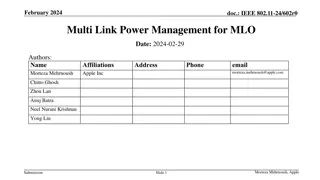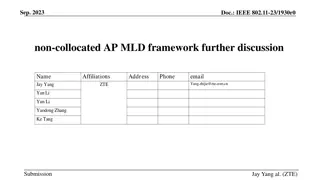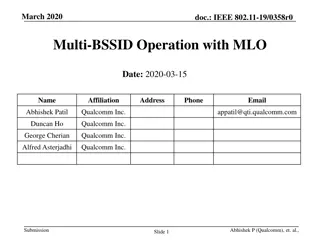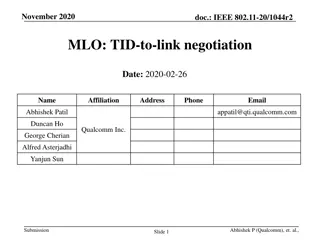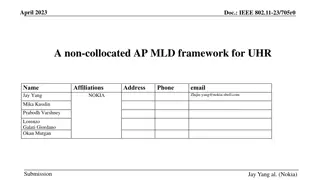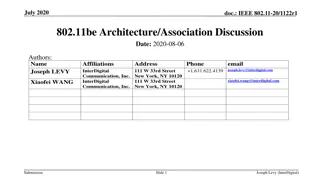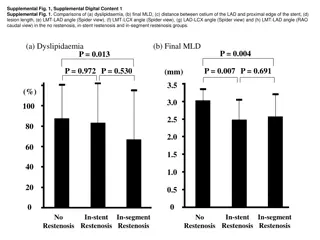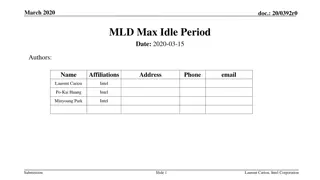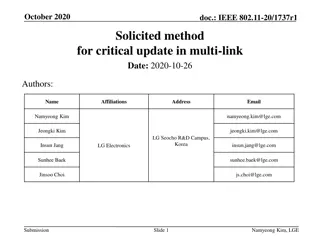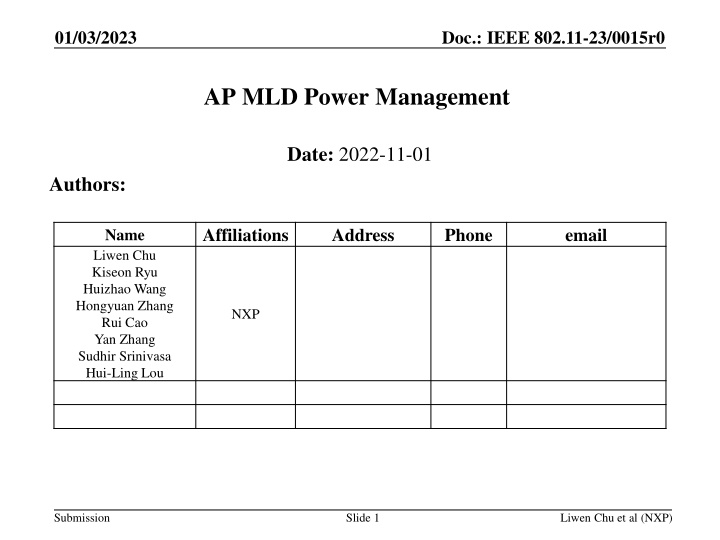
Enhancing AP Power Management in IEEE 802.11 Networks
Explore the latest advancements in AP power management in IEEE 802.11 networks, covering topics such as STA power save modes, dynamic power management, AP power management modes, and potential issues with MLD power management. Discover insights on BSS deployment and chipset shipment trends shaping the future of Wi-Fi technology.
Download Presentation

Please find below an Image/Link to download the presentation.
The content on the website is provided AS IS for your information and personal use only. It may not be sold, licensed, or shared on other websites without obtaining consent from the author. If you encounter any issues during the download, it is possible that the publisher has removed the file from their server.
You are allowed to download the files provided on this website for personal or commercial use, subject to the condition that they are used lawfully. All files are the property of their respective owners.
The content on the website is provided AS IS for your information and personal use only. It may not be sold, licensed, or shared on other websites without obtaining consent from the author.
E N D
Presentation Transcript
01/03/2023 Doc.: IEEE 802.11-23/0015r0 AP MLD Power Management Date: 2022-11-01 Authors: Affiliations Address Phone email Name Liwen Chu Kiseon Ryu Huizhao Wang Hongyuan Zhang Rui Cao Yan Zhang Sudhir Srinivasa Hui-Ling Lou NXP Submission Slide 1 Liwen Chu et al (NXP)
01/03/2023 Doc.: IEEE 802.11-23/0015r0 Recap: Non-AP STA Power Save Intra-PPDU power save SM power same Dynamic SM power save Static SM power save VHT TXOP power save Operating mode control Power management mode: Active mode Power save mode Awake state Doze state U-APSD/APSD Submission Slide 2 Liwen Chu et al (NXP)
01/03/2023 Doc.: IEEE 802.11-23/0015r0 Recap: Non-AP STA Power Save (Cont d) WNM sleep mode Power save under TWT Wake TBTT and wake interval Opportunistic power save TDLS power save Submission Slide 3 Liwen Chu et al (NXP)
01/03/2023 Doc.: IEEE 802.11-23/0015r0 Recap: AP Power Management Responder PM mode with individual TWT S1G AP power management Active mode Power Save mode Doze state Awake state Submission Slide 4 Liwen Chu et al (NXP)
01/03/2023 Doc.: IEEE 802.11-23/0015r0 Recap: MLD Power Save EMLSR Link Disabling Submission Slide 5 Liwen Chu et al (NXP)
01/03/2023 Doc.: IEEE 802.11-23/0015r0 Potential Issues with AP MLD Power Management Mode The association of non-UHR STA, non-UHR non-AP MLD The Active probing by non-UHR STA, non-UHR non-AP MLD Non-HE associated STAs assume that its associated AP are always available for frame exchanges except the quiet SPs Submission Slide 6 Liwen Chu et al (NXP)
01/03/2023 Doc.: IEEE 802.11-23/0015r0 BSS Deployment and Chip Shipment An AP can control the PHY types of the associated STAs through BSS Membership Selector In a BSS with old PHY types being disallowed, there is higher chance to enable AP power management. The designed protocol should harmonize with it. In the future, the market share of the old PHY types will become less and less. This can give higher chance to enable the AP power management. The designed protocol should harmonize with it. Wi-Fi chipset shipment forecast by IDC towards 2023 Submission Slide 7 Liwen Chu et al (NXP)
01/03/2023 Doc.: IEEE 802.11-23/0015r0 AP Device Types Mobile/soft AP( MLD) Most of them are battery powered, and have single radio NSTR mobile AP MLD Battery powered Regular STR AP MLD Powered through ethernet cable etc. The proposed power management proposal needs to support the power management of all these three types, especially the previous two types Submission Slide 8 Liwen Chu et al (NXP)
01/03/2023 Doc.: IEEE 802.11-23/0015r0 AP s Intra-PPDU Power Save and Dynamic SM Power Save Similar to STAs, an AP can stop its PPDU reception if the AP figures out the PPDU doesn t carry the frames addressed to it. By allowing AP s single RF chain and/or narrower BW to monitor the medium, the AP can save its power. The protocol needs to address the case when non-HE STAs or non-UHR STAs associate with the AP. Submission Slide 9 Liwen Chu et al (NXP)
01/03/2023 Doc.: IEEE 802.11-23/0015r0 AP Power Management Mode The AP power management mode includes Power save mode Doze state Awake state Active mode The protocol needs to provide the method that non-AP STA s buffered frame notification. The protocol needs to address the case when non-HE STAs or non-UHR STAs associate with the AP. Power management mode enabling/disabling per the STA type allowed to do the association with the AP. The protocol needs to address the active probing issue Frequently short AP Announcement. Submission Slide 10 Liwen Chu et al (NXP)
01/03/2023 Doc.: IEEE 802.11-23/0015r0 Method to Avoid Bi-direction Awake Soliciting and Notification Allowing the TWT based power saving at AP and STA side for both individual TWT and broadcast TWT. Both AP and STAs are awake within the negotiated TWT SPs. Outside the negotiated TWT SPs, the AP can go to power save mode. Submission Slide 11 Liwen Chu et al (NXP)
01/03/2023 Doc.: IEEE 802.11-23/0015r0 AP MLD Power Management Different affiliated APs of an AP MLD are in different power management mode. One simplification is that at least one affiliated AP is in active mode while the other affiliated APs are in power save mode. This can address the probing, association, non-UHR STA frame exchanges. This is less useful when the TID-to-link mapping is not equal to 3. Under TID-to-link mapping other than 3, if some affiliated APs are in active mode, the non-AP MLDs will transmit frames to the active affiliated APs. Submission Slide 12 Liwen Chu et al (NXP)


